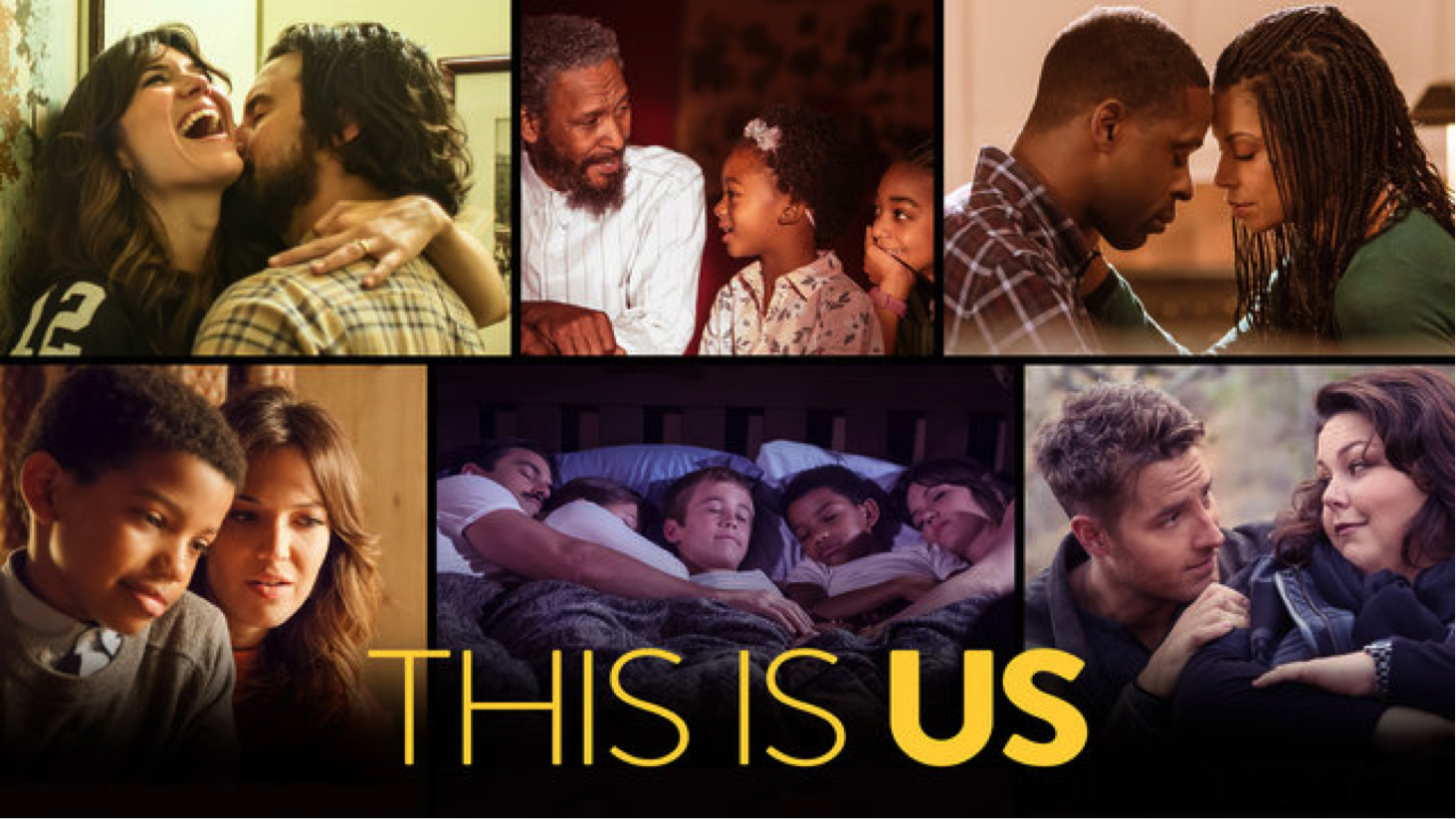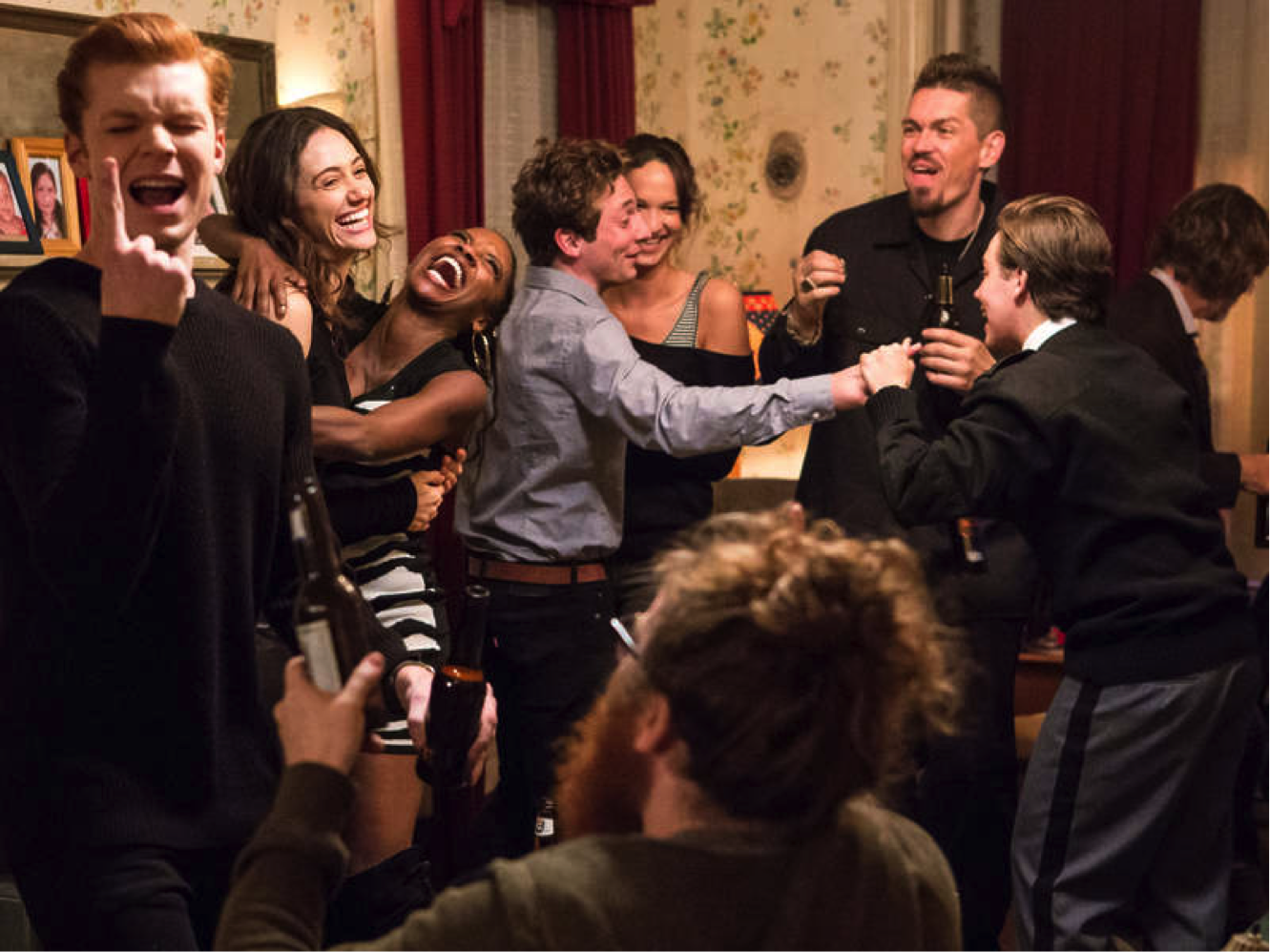"This Is Us" Series Unexpected Season One Finale
Over the course of six months, the new NBC series This Is Us has captivated audience’s hearts. The series tells the beautiful story that revolves around six individuals and how their lives connect as one family.
It is no surprise that the series was nominated for several awards, including screen actors guild awards and golden globe awards for best television series and best performances by an actress; This is Us has also won awards for the series’ overall quality from the People’s Choice Awards, the Writers Guild of America, the AFI awards, and more.
(Spoilers) As I sat down to watch the season one finale last week on March 14th, emotions were high. The previous episode had left off with the family patriarch, Jack Pearson, driving drunk on his way to make amends with his wife Rebecca. As most long-term audience members of This Is Us know, Jack faces an early death. His children are in their teens/early 20s when his passing occurs. But the "how" is still uncertain. Many expected this to be it, the big reveal of how Jack dies and the story behind his death.
Yet, pleasantly, the season finale of This Is Us did not end with a sorrow tone. Instead, there is hope and the promise of a future. These goals are not only shown through Jack and Rebecca, but a new possible life-altering avenue for Randall too. Randall proposes that he and his wife adopt a baby.
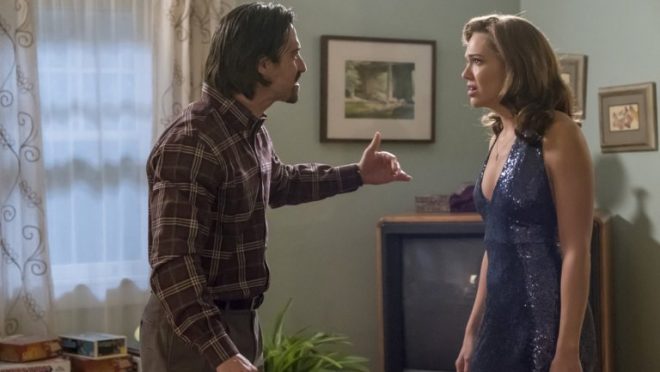
This decision allows the story to come full circle in a way. Randall's choice to adopt a child shows his understanding and appreciation for his parents on a new level. Randall realizes that although Rebecca didn’t make the best decisions when it came to Randall’s birth parents, she was always there for him 110%, and he believes that Rebecca did what she thought was best for Randall growing up. Although Randall didn’t get much time with his birth father, he understands how loved he was by William, Jack, and Rebecca. Randall, in turn, wants to give that same powerful love that he had with Jack and Rebecca to another child.
As for Jack and Rebecca, despite their hostile words exchanged with one another, they didn’t simply apologize. Although both felt guilt at the way the expressed their feelings, they both meant what they said. Rebecca even states this truth directly. Rebecca has sacrificed having something of her own, and her opportunity to have her “big break” as a singer was ruined by Jack who showed up drunk. She depicts herself as a house wife and a mother of teenage children who don’t need her anymore. Yet, Jack has visibly made sacrifices too; such as, asking his drunk abusive father for money, so Jack and Rebecca didn't have to move in with Rebecca's parents. But at the end of the day, Jack is fighting for his marriage with Rebecca. He is showing the lengths of his love for her, and that this is only the beginning of their story.
It is in this episode that we discover how Jack and Rebecca meet. It is a joyful revelation, rather than one filled with tragedy and pain. We, the audience, see how Rebecca saved Jack from acting out a really stupid plan; a plan that could have altered the course of his life and ruined his future. Rebecca was Jack’s “big break.”
Although many were anticipating the season finale to reveal the truth about Jack’s death, this episode gave audiences so much more in such a positive, uplifting way. It gives these characters time: time to mend, time to heal, and time to continue to build a life together with the ones that they love. The This Is Us season finale continues to tell the story of the Pearson family and their journey together.
Review: Big Little Lies Series Premiere
The newly premiered HBO series, Big Little Lies, centers around the lives of three mothers of first grade students. Although most of the parents are rich and have money, power, and status, no one’s life is perfect. The audience sees what really goes on behind closed doors. We see the struggles that each of these individuals face as mothers and as human beings.
At the beginning of the series, it is revealed that a significant member of the community, and the school that the children attend, has died at the fundraiser. However, a sense of mystery still remains, as the victim’s identity is not yet known.
There are moments throughout the episode that expose, or hint, the truth to the audience; the truth which is that these women’s lives aren’t perfect. This world that the adults of these children lead involve dark concepts, such as: murder, jealous, sex, abuse, alcohol. All of these ideals are in direct opposition to the morals children learn through there parents and teachers; this child-like innocence is paralleled by the outside world of the audience, who don’t see the real life complications that these women deal with in their own lives.
This world of the parents within their children’s elementary school community is depicted as “a vicious world of who can prove they have the most money.”
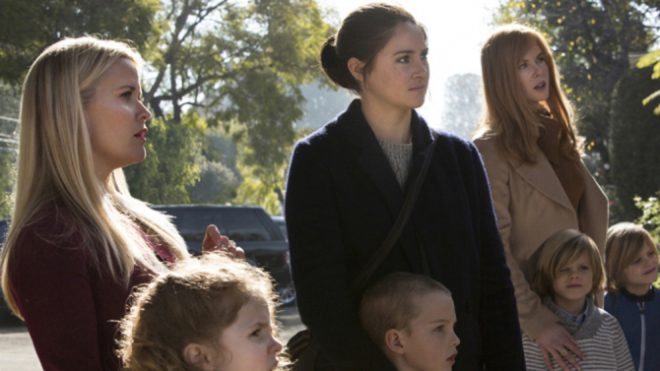
Madeline Martha MacKenzie, one of the lead characters played by Reese Witherspoon, is portrayed as preppy, pushy, and is in everyone’s business. Yet, despite having her nose in everyone’s business, she appears to have her head in the clouds. She doesn't seem to think before she speaks, or recognize the ramifications of certain actions; such as using the "f-bomb" in a children's play, or stating that emotional trauma and physical trauma are separate and don't coincide with one another.
However, Madeline recognizes that her children are slipping away from her; Madeline feels that she is loosing her children to her ex-huband and his new wife. Yet Madeline's actions show that she has her daughters best interests in mind. She tries to warn her oldest daughter, Abigail, about being a strong independent woman. She tells Abigail to use her opportunity to attend college, to be self-sufficient and not have to rely on others; an opportunity Madeline didn't have when she was a new, young mother. Abigail pushes her mother away at first, both physically and emotionally. Yet Abigail and Madeline have a moment that shows how they care for each other and that their mother-daughter bond can’t be broken. This struggle Madeline has with her children growing up shows her difficulty with the future.
Jane Chapman, portrayed by Shailene Woodley, is young, down to earth, and the mother of a boy in the first grade. Towards the beginning of the episode on the first day of school, Jane’s son Ziggy is accused of choking a little girl, Renata’s daughter Amabella. “That boy picked the wrong little girl to strangle,” one of the parents interviewed stated. This dialogue foreshadows how this event lead to a domino effect in the murder that eventually consumes the school. However, Jane believes that her son Ziggy didn’t hurt the little girl. She has faith and trust in her child. However, Jane may be hiding a secret of her own. The last clip shows Jane sleeping with a gun under her pillow. This image hints at the idea that Jane has a past, possible with her ex, Ziggy’s dad.
Celeste Wright, portrayed by Nicole Kidman, has two sons and a seemingly loving and passionate relationship with her younger husband. Yet, not all is as it appears to be. Celeste's husband is abusive, grabbing onto Celeste during an argument when she repeatedly tells him to let go; she pushes back and gets defensive during the altercation, as if this has happened before. Indications of abuse are also present during the beginning of the episode, when Celeste shares a moment with Jane. Jane depicts how in that moment, Jane is physically there, but mentally she is having an out of body experience. Jane’s reflection seems to resonate with Celeste, as she appears to be physically present but is seemingly mentally absent in certain scenes. Celeste’s current struggle takes place in the present.
Now that we have discussed the three main characters of the series, lets talk about the series as a whole.
In the first episode, there seems to be a bit of a separation between the story line and the characters. It almost appears as if these individuals and their stories are more significant than the overall story at hand. Yet, this separation also shows the split between the character’s lives that they lead outside of being a mom. This sense of disconnection highlights the real, raw emotions and conflicts that they each face in their lives.
Additionally, there is a theme of violence that runs throughout the first episode. From the abuse towards the little first grade girl Amabella to Celeste’s abusive husband, from Jane’s need to carry a gun to protect herself against someone, and most importantly, the murder. All of these potentially threatening physical situations lead to the murder, and provide support as to why the murder occurred.
Although all the pieces of the story seem separated, they all make perfect sense in the context of the story. We, the audience, can see the direction of the story’s trajectory in future episodes. The murder provides a strong tether to all the other pieces of the story, in addition to the character’s witness statements. All of these segments show how the story will come together and connect the characters and the story.
TV Review - Riverdale Premier
The series premiere of Riverdale, based off the 1940s comic book series Archie's Comics, features high school students and their day-to-day lives in the small community of Riverdale. However, just because the town of Riverdale is a confined neighborhood, doesn't mean that it's quiet.
The narrator in the series Riverdale presents the town as originally "wholesome and decent.”. However, deeper investigation into Riverdale shows that Jason Blossom’s death tainted that purity, and that with it the town changed. However, even before Jason’s death, Riverdale and it’s residents were filled with secrets. This world is much different than the people that make up Riverdale in the original comics, Archie’s comics. Archie Comics was established in 1939 by founders Maurice Coyne, John L Goldwater, and Louis Silberkleit.
The leading characters that appear in Archie’s comics are Archie Andrews, Betty Cooper, Jughead Jones, Veronica Lodge, Kevin Keller, Cheryl.
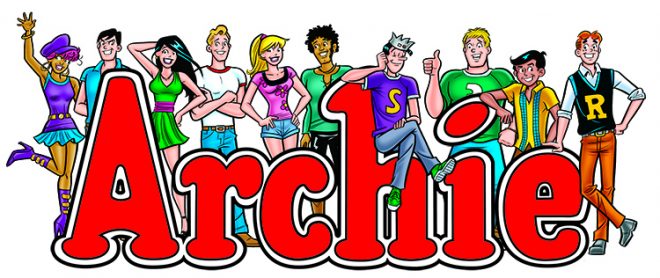
The series premiere of Riverdale starts with a dark beginning, the death of Cheryl Blossom’s twin, Jason Blossom. This grim twist presents dismal mood from the very beginning of the series. This tone is very different for Archie's comics fans, who may be comfortably familiar with the happy, up-beat tempo of Archie Comics and the characters within Riverdale.
With the tone completely altered, changes in the characters, and their personas and relationships with others also appear different from the comics.
Archie’s passion for writing music presents him as a 3 dimensional character who has passion and drive in his life. Archie is not just the typical teenage boy who is stuck between two girls, as he is viewed in Archie Comics.
Jughead Jones, who is depicted as Archie’s best friend in the comics, is the narrator. His grave, serious tone alter from the eating machine and “everybody’s pal” persona that Jughead’s character takes on in the comics. He is smart, and analytical, although Jughead Jones possesses certain analytical characteristics/qualities in the comics. Jughead is only heard, but rarely seen in the first episode. He’s a loner, unlike his persona in Archie’s comics where his role is as Archie’s best friend. Instead, Archie’s best friend in the series is Betty. Towards the end of the episode, they reveal that Jughead and Archie used to be best friends, but aren’t anymore; and that communication, or Archie’s lack of communication, lends a hand the demise of Archie and Jughead’s friendship.
Veronica arrives new to the town of Riverdale in the first episode, where no one really knows her. This, again, presents a difference from the already established persona Veronica takes on as the popular, rich girl at Riverdale high school.
Instead, depth is given to the character of Veronica in the Riverdale series. She is elegant and intelligent, even making a Truman Capote reference/joke to Archie when they first meet. Veronica breaks outside of the two dimensional character renders in Archie comics. In the comics, Veronica is simply a girl who loves to shopping and uses her wealth to get whatever she wants, including Archie.
Betty is intelligent, active and strong, similar to her portrayal in Archies comics. Many even deem her to be "perfect" in the series Riverdale. However, she has her weaknesses, namely her sister Polly and her lack of confidence in confronting others, namely Archie and Cheryl.
Betty and Archie aren’t together in the first episode; Archie's attraction to Veronica is immediately and powerful, barely even noticing Betty in the same way. This dissolves the love triangle concept between Betty, Archie, and Veronica in the comics. It also shows that strong women like Betty and Veronica wouldn't stand to be in a love triangle and fighting over Archie, or at least to the extend within the comics.
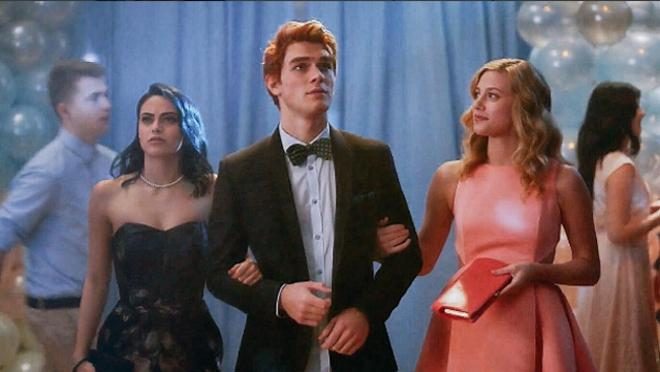
Betty’s mother plays a major role in the Riverdale story, all the parents do in some way. The parents all have a stake and a role in Riverdale, before their children’s stories. Namely, the parents feature Alice Cooper, Betty’s mother, Hermoine Lodge, Veronica’s mother, and Fred Andrews, Archie’s father. Even Hermoine’s husband/Veronica’s father and his reputation plays a role in Riverdale. Fred and Hermoine even have a past as “friends.”
Alice Cooper, Betty’s mother, portrays the obsessive and controlling parent. She continues to hate Jason Blossom even after his death. Alice continuously accuses and blames Jason for destroying her daughter Polly’s future and her subsequential mental breakdown and placement into a group home. However, although Jason hurt Polly, Betty states that it was their mother who broke Polly by disowning her. Similarly, Alice puts an extreme amount of pressure on Betty as a sophomore, scrutinizing her choices in academics and after school activities. Betty has a prescription for Adderall for her ADHD, which her mother refills for her. Although the audeince may perceive this action as Alice’s overbearing and dominating actions over her daughter, there is something deeper at work. Showing Betty’s ADHD medication adds depth to her character, that she isn’t as perfect as other people expect of her.
Cheryl Blossom, who faces the tragic loss of her brother’s death, feeds off of chaos, fear and intimidating others. Cheryl’s character takes a darker twist on her simple need for attention within the comics. She not only craves attention, she craves destruction.
Additionally, the character Josie also presents depth through diversity, in relation to the comics. Josie is black, along with the other members of Josie and the Pussycats. These racial and cultural elements, which differs from the comics, adds dimension to the series.
However, Kevin’s role is lacking in the series, compared to the comic books. He plyas the role of Betty’s gay best friend in Riverdale; where as in the comic books, Kevin has his own likes, and dislikes and his own persona as a character that stands out in Archie’s comics. This general characterization overview is also seen in Moose’s character, as well as Reggie’s character. In fact, Reggie plays Archie’s friend in Riverdale; this characterization of Reggie is very much the opposite, as he serves as an arch enemy of sorts in the comics, with Reggie's constant teasing and self obsession.
The language and demeanor of these characters is very typical of modern day high school and their roles. They are classified as popular, gay best friend, jock, musician, geek/scholar. Yet, they all have complexities within their individual characteristics that make them people, not categories in a high school’s social system.
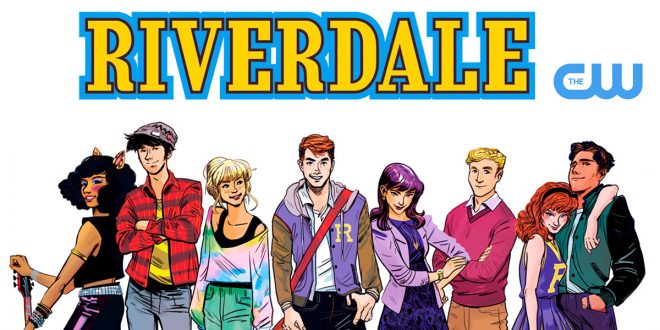
Some of the biggest complexities presented in these characters are their confidence, character development, or their need to take action.
Archie’s sexual relationship with his teacher, Geraldine Grundy very different from the tone of Riverdale in the comics. It begs the questions, is it his relationship with his music teacher that drives Archie to music? The relationship between Archie and Geraldine fell out. Yet, they are still and forever bound by the sound of the gunshots that they witnessed on Fourth of July weekend, when Jason Blossom was found dead. Archie wants to come clean about what they heard. However, Ms. Grundy doesn’t want to face the backlash of reporting the shooting and jeopardizing her life as a teacher by admitting to having had relations with a students. This complex, darkened plot is VERY different from the comics.
Veronica shows her loyalty and stands up for Betty, who isn’t confident when face by Cheryl. Betty’s lack of confidence is in opposition to her portrayal in the comics, as strong and confident women. But in the real world, everyone has their weaknesses. Veronica’s speech about reckoning and that wealth doesn’t last originates from her personal experience. Veronica’s father’s demise lead to Veronica’s own reckoning, and the subsequent realization that she was like Cheryl. It also led her to the path of becoming a better person. Veronica states that she wants to use Riverdale as an opportunity to become “a better version" of herself. Veronica’s character development allows her to stand up for herself, as well as others for what is right. This progression comes after realizing her faults and the wrongs she has done to others in her past.
Veronica, again, stands up for Betty, using her confidence to give Betty what she is too scared to seek out; for example, becoming a cheerleader or asking Archie to the dance.
Betty, in turn, stands up for herself and stands up for Veronica as her friend. Betty tells her mother that she is always doing everything for everyone else. She's trying to obtain this perfect persona(s) for those who set her to an impossible standard. Now, it’s her turn to break away from her role of this “perfect” person in all aspects of her life. She finally takes the opportunity to act on what she wants.
This series presents complex qualities, such as: strength, confidence, maturity, growth and passion and desires that each characters have. These features add three dimensional characterizations to characters; rather than keeping them at bay with the one/two dimensional traits that the characters possessed as somewhat average teenagers in Archies comics.
Jason’s body washes up on the shore, with a bullet hole mark left on his forehead.
“Riverdale wasn’t the same town as before, it was a town of shadows and secrets now,” Jughead states at the end.
The series Riverdale presents the question: is this version of a dark Riverdale the aftermath of what Archie’s comics used to be? Is this town of secrets the result of what can happen when people’s desires complicate and change the dynamic? Or has Riverdale always been tainted with private affairs that are tucked away behind closed doors, even from Fred Andrews, Hermoine Lodge, and Alice Cooper’s era in Riverdale. Does the cycle simply repeat itself?
A Series of Unfortunate Events: A TV Series About a Series
The Series of Unfortunate Events, told by narrator Lemony Snickets, is a series of 13 novels that first released in 1999. On January 13, 2017, Netflix released the A Series of Unfortunate Events as a Netflix Original. Although there are over a dozen novels, the first season of the Netflix adaptation covers the first 4 books: Bad Beginnings, The Reptile Room, Wide Window, and Miserable Mill.
[iframe id="https://www.youtube.com/embed/MGhd6dpRy-w"]
I still vividly remember searching for and reading these books in my school library when I was in 5th grade. Although I remember seeing the movie version of this series, which covered the first three books, the movie franchise never continued. This left fans in the dust, only getting a taste of A Series of Unfortunate Events and on-screen vision, until January of 2017.
The scene opens with the three Baudelaire children, each of their characteristic qualities which are explained to the audience through the aid of narrator Lemony Snickets. The infamous villian, Count Olaf, soon enters the picture as he is the first stop on the Baudelaire guardian tour. It is immediately evident that Count Olaf's character has a narcissistic personality and selfish actions that follow in suite. However, Count Olaf's story is more complex than his relentless ploy to get his hands on the Baudelaire fortunate. A story, that by the end of the first season, the audience begins to realize a relationship between all of the characters who have appeared throughout the series. From Count Olaf to Montgomery Montgomery to Aunt Josephine, they are all connected. And there is more that lies deep under the surface.
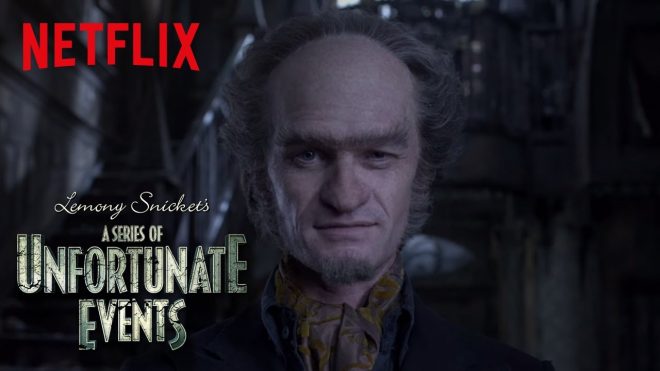
In relation to the novels, Netflix did a spectacular job of bringing this world to life. The visual aspects, such as the characters, the costume design and the set design, all are in perfect coordination with the books. But the effect the appearance has on the audience also, in turn, greatly effects the tone of the story. For example, playing with dark vs. light in the houses that represent joy and light for the Baudelaires; such as Justice Strauss' house and Montgomery Montgomery’s home. While Count Olaf’s residence and Aunt Josephine’s eerie home are very dark, dull and lifeless. This represents how viewers picture these characters that serve as the host(s) of the house.
Lemony Snickets, the narrator in A Series of Unfortunate Events, is front and center in many of the scenes. He explains and foreshadows what is to come for the Baudelaire children, as a narrator typically does in a story. But it is unusual to see the narrator so often and up-close in the world of television and movies.
Incorporating the narrator into the on-screen adaptation of A Series of Unfortunate Events is essential. Not only does the narrator’s presence maintain the original story and how the audience received character and plot information; but the very idea of Lemony Snickets was also created as a fantastic figment by the author. We see the author’s internal thoughts coming alive from the book to its on-screen translation. Through the aid of Lemony Snickets, the audience can almost see the author’s presence (Bad Beginnings part 1).
One of the most notable qualities of A Series of Unfortunate Events is the story’s use of irony. The dark and twisted irony is a literary rarity not typically found among children's books.
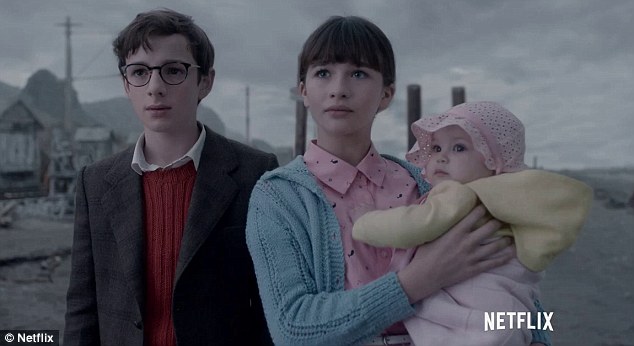
In Reptile Room part 1, Lemony Snickets defines and explains the meaning of dramatic irony. As adults, we know what this is and can pick up on it. But as children, the explanation of this word and its context in a children’s book is important to reinforce. This is one facet that depicts how the creators refused to change the nature of the story and how it is told, even if the audience is older. The essence of A Series of Unfortunate Events and how the creator portray the on-screen story remains true to the book.
Despite the awful or “unfortunate” series of events that unfolds, a strange sense of humor persists in the face of these hapless occurrences (Bad Beginnings part 1).
The use of irony in the series becomes even more blatant, if that’s possible, in Wide Window. For instance, the town of Paltryville's name is originally titled as a misnomer (paltry meaning small or meager). The town was vivid and lively, but eventually became paltry due to environmental factors.
Another great example of irony in this series is Aunt Josephine. She seemingly has a phobia of everything under the sun. She believes everything poses a threat and that she, and those around her, are in constant danger. Yet, Aunt Josephine’s character chooses to live in a house hanging at the edge of a 300 foot drop, with a lake below that contains lachrymose leeches. However, ironically, Aunt Josephine’s fear of “real estate” super-cedes her fear of living in the dangerously structured and located house. Her irrational fear trumps what should be a rational fear. Two concepts, rational and irrational fears, which are defined by Lemony Snickets.
A Series of Unfortunate Events is also memorable for using great examples of literature. This strategy not only teaches children of these praiseworthy authors and novels. But Lemony Snickets also uses these books and/or figures to help get his point across and to create understanding in a humorous manner.
For instance, he describes the expression “out of the woods” in Miserable Mill part 1. Lemony Snickets depicts the saying as almost away from threatening danger. The narrator explains that that woods are often perceived as dangerous places to be, as shown fables/stories of fiction, such as Hanzel and Gretle, or Little Red Ridding Hood. Following the comparison of children’s tales, the narrator uses the great work of literature Walden, as another example. Although some may not be familiar with this reference, the humor is in the simple nature of tall tales versus the complexities of transcendentalist Henry David Thoreau.
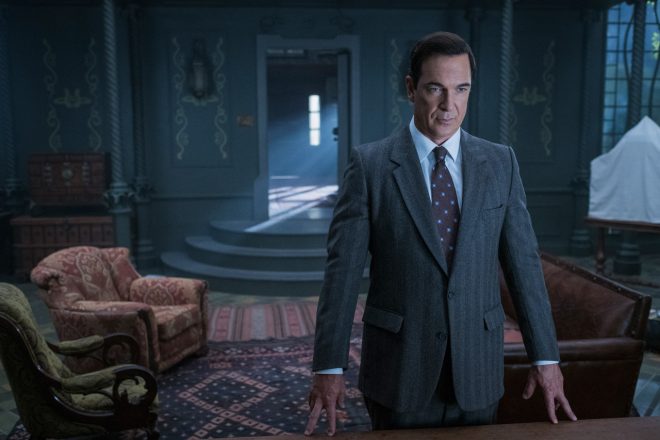
The next example shows Klaus when he spots a sign in the shape of a pair of eyeglasses hanging over the entrance of the optometrist office. “In The Great Gatsby, there’s a famous sign shaped like a pair of eyeglasses. It represents the eyes of God staring down and judging society as a moral wasteland,” Klaus said.
“That sounds like a fun book,” Phil the lumber mill worker replied.
Even for those who don’t inherently understand the reference, this example of literature presents a sense of complexity (or complex works) paired with a lighthearted comical response. Additionally, the idea of the "moral wasteland" and the destitute and greedy nature that continuously pursues wealth is a concept depicted shown throughout the A Series of Unfortunate Events, namely seen in Count Olaf and Sir and the miserable mill.
As previously mentioned, foreshadowing is another major component that is often employed throughout A Series of Unfortunate Events. Lemony Snickets directly states that unfortunate events will follow, which is unknown to everyone accept the narrator in this case. Lemony Snickets foreshadows many of the unfortunate occurrences. For example, Montgomery Montgomery’s death and how the children would be on their own again soon. Or the Baudelaire children, who were not “out of the woods yet, they were far from it.”. This line vaguely hints at the unfortunate events that the children soon would face in the next chapter of their story.
However, foreshadowing isn’t an exclusive product of Lemony Snickets. The character Sir foreshadows that the Baudelaires didn’t actually set the fire, as accused. However, Sir only hints at this truth without explanation when he speaks to his co-worker, Charles, who knows the situation and does not need explanation. Yet, this lack of elaboration leaves those unknowing, such as Violet and the audience, hanging in the balance with questions (Miserable Mill, part 1).
In Miserable Mill, part 2, Lemony Snickets presents the concept of black and white. The narrator is shown visually in a black and white on-screen performance. He explains that looking at things 'in black and white' is "oversimplified and often incorrect.” There isn’t simply good and evil, or right or wrong, or fact and fiction in this world. There is always a spectrum and there are always new details to uncover. Even in the Baudelaire’s fictional world, the lines are always blurred. The grey isn’t depicted or explained.
Another brilliant literary strategy that this novel/on-screen adaptation uses is satire. This narrative technique shows the intelligence of children versus adults and how this discrepancy is viewed in society. Mr. Poe’s constant word explanations to the children, from the beginning, shows his ignorance for children as intelligent human beings. This is an important lesson - or rather realization - to understand, not only for children, but for adults as well. Adults often have this misconception that children are mentally naive, that they couldn’t possibly understand the complexities of science, or literature, or the world around them. In this story, the roles reverse and it is the adult characters in the story (namely Mr. Poe) who are actually the ones who can’t comprehend the situation(s) at hand.
At the end of the season’s final episode, there's a parallel present between the Baudelaire children and the Quagmire children. Violet and Klaus sit on one side of the bench while the Quagmire children sit on the other side. Each clan, the Baudelaire’s and the Quagmire’s, holds one half of the broken spy glass. The Quagmire’s house set fire, as did the Baudelaire’s mansion. The Quagmire’s parents were in the picture that Klaus possesses from his Aunt Josephine; a picture that also shows the Baudelaire’s parents in the photo (as confirmed by Aunt Josephine and Klaus in Wide Window, part 2). This constant mirror image between these two families is something to take note of. The two share a connection.
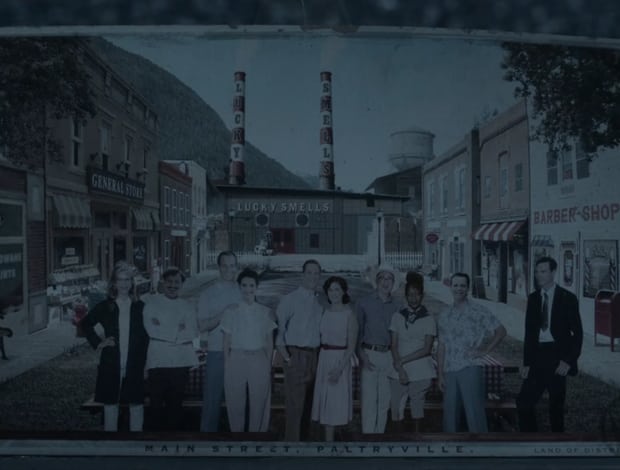
Towards the end of the season, Violet asks Klaus about a quote Samuel Beckett once said.
“I can’t go on, I’ll go on,” Klaus responded.
“Lets go on together,” Violet said.
This moment continues the ironic tone that is present throughout the series. The series employs irony in a way that wraps up the story. It also shows that the Baudelaire children will keep pushing through. Despite the obstacles and the feeling that all of these unfortunate events are unbearable, the keep moving forward. They still continue to go on.
Shameless Season 7 Wrap-Up
This past Sunday, on December 18th, Shameless wrapped their season 7 finale. Throughout the season, we, the audience, see each character’s highs and lows, both individually as well as collectively as a family.
Frank:
- In season 7, Frank’s world is shaken again by the return of Monica, his wife that has abandoned him and his children over and over again. However, this time, Monica explains to Frank that she is dying. At the end of season 7 episode 11 and into episode 12, Monica passes away in Frank’s arms. From the announcement of Monica’s death at the hospital to Monica’s funeral, each scene shows Frank love and devotion to Monica. As many times as Monica screwed Frank over, he still welcomed her back every time because he truly loved her. Frank’s speech at Monica's funeral puts things into perspective for the Gallagher children. “I know you didn’t think much of her, but she loved you. You wouldn’t be who you are and I wouldn’t be who I am if she didn’t come into our lives. So, hate her if you want. But she’s in you. And that’s a good thing,” Frank says. Frank’s speech shows Fiona, Lip, Ian, Debbie and Carl that in her own messed up way, Monica really did love her children.
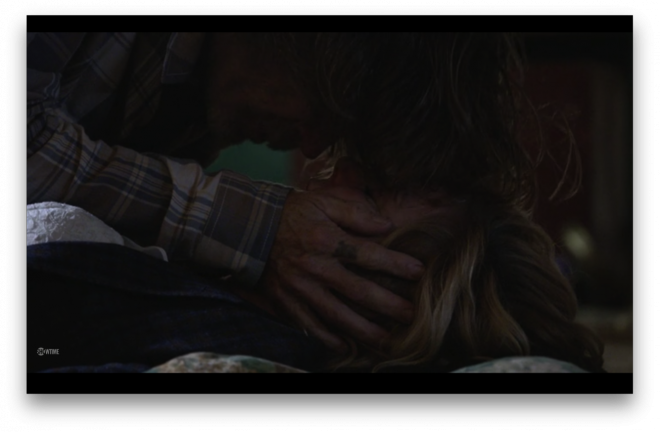
Fiona:
- In season 7, Fiona is establishing herself as a business woman and aspiring to become a property owner, to own something that is hers. Throughout the season, we see Fiona make some tough decisions in putting her foot down. She refuses to continue to take care of her family members problems before her own anymore. Fiona gives up the first property that she owned, the laundry-mat, for the money. As a result, she starts to make business decisions first rather than considering the choices that affect her friends and family. One example of this is Etta, a local who used to own the laundry-mat in town. Fiona promised to buy the laundry-mat and to let Etta live in the apartment upstairs. However, Fiona takes the $160,000 offered to her and turns her back on Etta, putting her into assisted living.
- However, Fiona’s denial to sell the $10,000 worth of drugs left to her by her mother shows her moral line when it comes to making money. She is no longer scraping to get by, she has a plan for herself and for her future that will allow her to prosper. Fiona isn’t simply buying properties out of money or greed. She wants to be successful, and she is willing to make some difficult decisions in order to get there.
- Near the end of the episode, Fiona also reveals her feelings about her mother after Monica's death. “She didn’t love any of us. She didn’t give a shit about anyone but herself,” Fiona said. “I’m glad she’s dead, at least she can’t fuck us over any more.” This scene, along with the scene where Fiona is left alone with her deceased mother, reveals how Fiona felt about Monica at the end of their relationship. Fiona hits Monica dead body in the pit of her stomach, the same pain Fiona felt for so many years being abandoned by her parents time and time again and having to take care of each of her siblings as if they were her own children.
- Fiona and each of the Gallagher children that she raised into the strong, ambitious characters that they are will no longer be undermined or disturbed by Monica’s words or actions.
Lip:
- In season 7, we see Lip’s struggle with alcoholism and addiction. Towards the end of the season 7 finale, Lip says, “I think I really fucked it all up.” Lip believes that it may be too hard to start over. But with encouragement, he realizes that he is surrounded by people who love him and believe in him. From friends and family, to someone he hasn’t known for more than a few weeks, they all encourage him. They support Lip, telling him that he can stay sober, that he can go back to school, that he can still have the future that he deserves.
Ian:
- In season 7, Ian attempts to get his life together. He searches for a stable, healthy relationship, and works hard to establish a career path that he loves. Ian finds that in helping people, working as an EMT. However, towards the end of season 7, Mickey comes back into Ian’s life. Ian initially choose Mickey and the passion that they have together over a stable life. However, he soon realizes that this life style that him and Mickey shared together, running away from their problems and living in the moment rather than planning for the future, that this isn’t Ian’s life anymore. Ian knows that he needs stability. Despite Ian's love for Mickey, Ian makes the decision to leave him for the sake of his own life. In one of the final scenes, Ian goes to the boarder patrol location to watch Mickey, making sure that he passes through safely. Although Ian tells Mickey he loves him before he leaves him, his actions of making sure Mickey is safe shows the extent of how much Ian really loves Mickey. Similar to Fiona’s situation, Ian has to make challenging decisions, even if it means letting something or someone you love go.
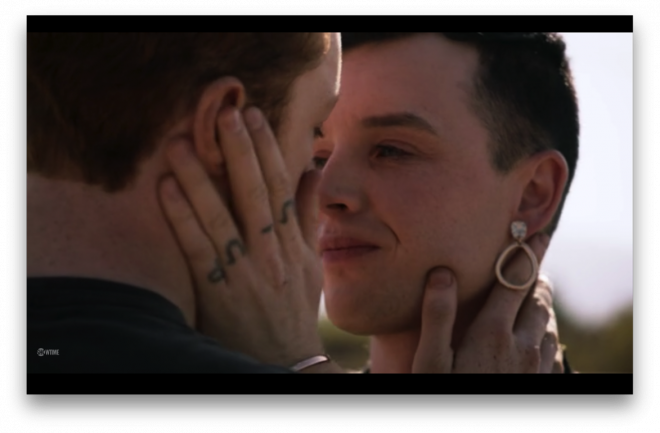
Debbie:
- In season 7, the audience sees the aftermath of Debbie’s highs and lows and her struggles as a single mother. Debbie has figured out a plan for herself, marrying Neil, finding a home, plans of attending welding school. She plans to establish a career for herself; rather than just marrying someone who has money or getting by with a part-time job. Debbie is doing what she has to do for the sake of her child. It shows her progression as a character and as someone responsible for another life.
Carl:
- In season 7, Carl chooses to leave the South Side and attend military school. Carl has always been there for his family, even though he has made terrible decisions. But the affect of military school has seemingly taught Carl to have respect for his family and those around him. An example of this is when Carl picks up groceries for his family on his way home from military school. This simple act displays his thought and consideration for his family in a new light. But the reason's behind his choice to attend military school are greater. Carl’s decision allows him to create a future for himself that is better than the environment he was forced into. Growing up, Carl served as Frank's right hand man, helping Frank in whatever scheme he has plotted. At the end, Carl helps his father one last time, giving tribute to his mother with an old activity (tagging). Carl is the youngest of the Gallagher siblings, with the exception of Liam, who is able to comprehend what is going on. He is able to make his own decisions. Yet, Carl's sense of devotion and loyalty in supporting his family members, towards even his addiction driven parents who abandoned him over and over, is still strongly in tact.
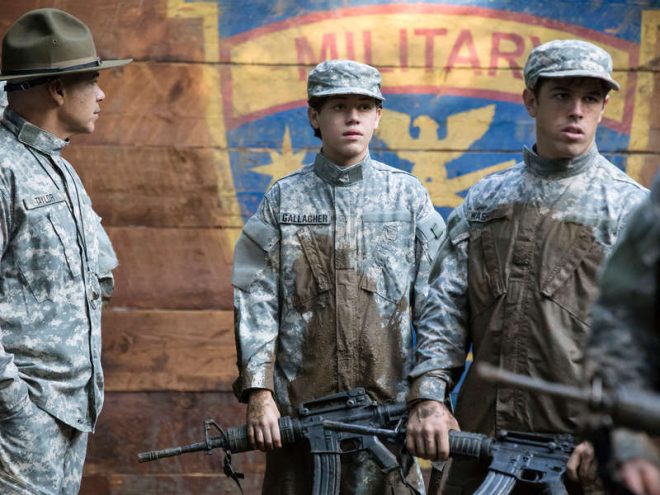
At the end of season 7, the closing scenes highlight each of the Gallagher children who are no longer children. They are, or are becoming, adults. Each of them are planning for their futures and how they are going to do better and be better than their parents, despite the obstacles put in front of them.
- Debbie is attending welding school classes.
- Ian returns to his job as an EMT
- Lip continues to go to AA meetings for his alcoholism
- Fiona takes the apartment complex building and starts her career as an owner of a property
- Carl is devoted to military school
In past season finales, there have been small moments. Moment of closure or defeat or conquer for certain characters, or a dramatic cliff hanger that left the audience waiting. But in the season 7 finale, everyone had their own moment of closure after Monica’s death. Monica’s death shows how each Gallagher faces the loss of someone who was never really there for them; but it also provides them each with something greater. The season finale's ending shows each of the Gallagher’s creating and planning for their futures, something Frank and Monica could never grasp.
American Horror Story Season 6 Poorly Executed
The new season of American Horror Story focuses on a Roanoke Theme. While an interesting plot concept, the execution of this season’s formatting and how the story is told is overbearing.
The story opens with characters in present day, speaking in front of a camera crew about their experience in the "roanoke” house. The set up of this story's structure seems planned out, a little too easily planned out. From the beginning, the characters are telling and recounting the scary events that happened to them, rather than showing these events. This idea appears out of the ordinary of the show's structure over the past 5 seasons.
[youtube id="3KUjpSNDlY4"]
The first 5 seasons of AHS showed, sometimes in disturbing detail, what the story was about in real time. It depicted the characters’ relationships with one another and their character arcs; it also showed their emotional journeys on their own and in relation to other characters. The psychological adventures that each season put the viewers through allowed us to have a detailed view of each story line; a story of what it looked like to be in the murder house, an insane asylum, in a coven, at a “freak" show in a circus, and in a (haunted) hotel. This was accomplished by characters through showing instead of telling the audience.
The beginning of season 6 narrates what happened to the victims of the roanoke house, followed by showing; which is a jarring idea. The episode flips back and forth between actress Lily Rabe and Sarah Paulson; both supposedly play the character of Shelby Miller. When I noticed this was also the case for the two male actors that played the roll of Matt, I made the connection. Like in most documentaries, stories are depicted by the retelling of what happened from the first person point of view and shown through actors reenacting these true life stories. However, in this case, it is confusing.
Usually, when re-telling a story in a documentary, it alternates between the retelling of these stories by the people that lived through them; this is supplemented in documentaries by short snippets of flashback scenes with actors who play the real life victims. However, these scenes of flashback using actors seemed overly real and detailed, compared to real documentaries. There was no need for both the interviewing of the “true life” survivors and the actors who showed this story. Considering that this is a television series, it seemed excessive here.
Showing these scenarios that make up the story using one set of characters would have been powerful enough to carry the story. It also could've refrained from confusing the audience/viewer.
There was a slow, natural progression of strange event leading up to attack on Shelby’s life, which was well planned. However, right after the attack occurred, the next moment cut to Matt narrating the scene; Matt (the actor) arrives home with police surrounding his house after Shelby’s attack. This then cuts to the aftermath, which also seems like an easy out. Their was a choice between showing how the attack unfolded or easily moving the story into the next scene. The route that is taken neglects Shelby’s thoughts and reactions after she had just been assaulted; it seems as if it were easier for the writer/s to cut to Matt’s reaction. This fails to allow Shelby to assess what just happened to herself.
Half way through the episode, Lee (Matt’s sister) enters the picture. This seems like a normal act, considering Lee is a cop and Matt wants Shelby to be protected. Yet, the flash of scenes showing Lee’s life events over the narrator’s voice, again, seemed too easy. Instead of showing a progression of these details throughout the story line, the writer gives them up too quickly. The scene focusing on Lee abruptly dives into Lee’s story, taking the viewer out of the current story at hand. It disrupts the flow of the story line. This, in turn, extinguishes the build-up and lowers the possible climax the story could have.
In this case, the documentary style of telling a story in past and present in a television show also spoils the ultimate question: the question of whether the character/s is going to live or die during the course of the episode or series. The fact that these characters are alive to re-tell their story means that we, the audience, know they will survive. No matter the actions taken by the perpetrator/s throughout the story line, they will live.
Showing these character arcs are during scenes of action and dialogue is essential and strengthens the story; instead of weakening the story by the simple re-telling of what happened. This plot line had the potential to be powerful standing on its own, without the addition of narration and retelling. All of the details that were told to us, the audience, could have easily been manufactured into scenes that shows what the characters thought and felt.
Overall, while the plot of the Roanoke theme is well formulated and even well executed in scenes, the re-telling of these events in a documentary-styled fashion draws the viewer out of the story and spoils a large piece of the story as well.
"This Is Us" Premiere Review (WARNING: Spoilers)
The television series This Is Us, shows 4 individuals that are born on the same day, celebrating their 36th birthdays. The story starts out and centers around 5 individuals: Jack, Rebecca, Kate, Kevin, and Randall.
[youtube id="rfUiKg28r_M"]
A couple of these individual's lives intersect directly with each other at first glance. Although they are all at the same age, they are facing different battles at 36. Jack and Rebecca are a married couple that are expecting triplets. Kate is an assistant and is struggling with food while attending an overweight support group. Kate’s brother, Kevin, is at a crossroads in his career; he doesn’t feel his current role as an actor is filling up to his career potential. Randall has established a family of his own, with a wife, 2 daughters, and adoptive parents. Yet, he feels he needs to find where he came from and is searching for his birth father.
All of these lives that are seemingly interconnected stories comes together in the end. It is revealed to the audience that they all belong to one family; Jack and Rebecca are the parents, Kate and Kevin are their biological children that survived the pregnancy, and Randall is the third adopted child.
Towards the end of the episode, when Kate is making this revelation, she repeats a quote from her father. “Do you remember what dad would say when ever something crappy happened to us?” Kate asked Kevin. There is emphasis here on the word US, both as triplets and as a family as a whole.
During the flashback to 1979, the delivery doctor breaks the news to Jack about his and Rebecca’s third child. But the doctor also shines profound light on the situation, based on his own past experiences. “There’s no lemons so sour that you can’t make something resembling lemonade,” the doctor says. This not only sets a hopeful tone. It also allows the character facing the situation to visualize this concept through the actions that they take. An example of this is shown through Jack and Rebecca by taking home 3 children that day. This goes back to what the doctor said when he first told Jack that only 2 children survived. “If you can take the sourest lemon that life has to offer and turn it into lemonade; then you will still be taking three babies home from this hospital. Maybe not the way you planned,” the doctor says.
Jack and Rebecca accept their role of being parents of three children. Even if the situation isn't what they anticipated. This action proves that family is stronger than biology. Family is support and unconditional love for one another. Interconnecting stories of “strangers” connects into a single family dynamic, with various character arcs and paths running through them. This provides room for the story to open up. It also allows us to see these individuals in a new light. It allows the audience to see the connection the characters have with one another in the past, present, and future settings. This is life.
WWE SummerSlam 2015: Results and Match Reviews
WWE SummerSlam 2015 promised to be the biggest and best SummerSlam of all time. Almost four hours of action and 10 matches with two main events, including the long-anticipated rematch between Undertaker and Brock Lesnar. The show had Jon Stewart as host, a match with Arrow's Stephen Amell, and a guest appearance by Mic Foley.
But let's face it, SummerSlam 2015 was a stinker.
If Monday Night Raw is three hours that should be cut to two, SummerSlam 2015 is four hours that should be cut to about two and change. Too many inconsequential matches, screwy finishes, and just bad writing and booking. NXT: TakeOver, which took place the night before SummerSlam 2015, was just over two hours, and a reminder of why quality is more important than quantity. Hell, indie promotion Ring of Honor's Field of Honor show in Coney Island over the weekend was far better than SummerSlam 2015 too.
I feel bad for anyone who paid for SummerSlam on actual pay-per-view.
Let's go through the weekend of wrestling in Brooklyn and then consider the results, the highs, and the lows of SummerSlam 2015.

